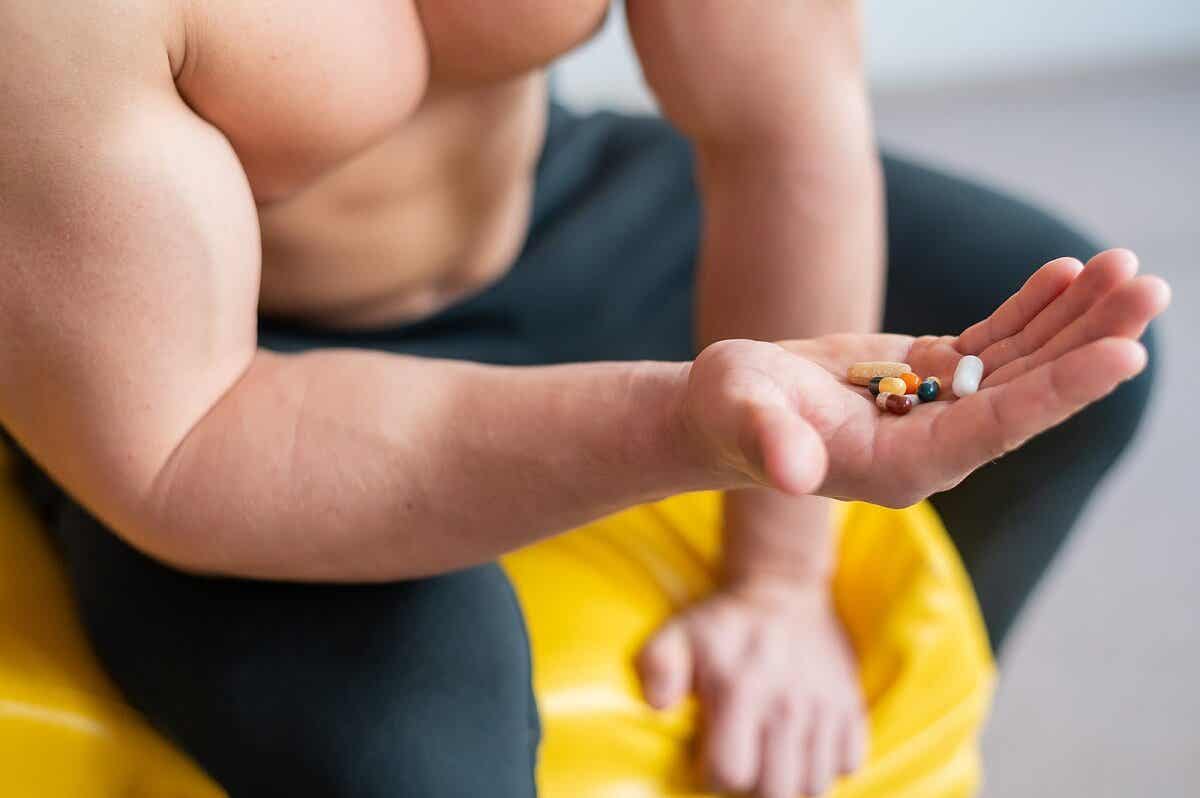Palumboism: The Effects of Steroid Excess in Bodybuilders


Written and verified by the doctor Diego Pereira
The effects of steroid excess in bodybuilders make up a very important topic.
Palumboism is a rare physical condition that affects bodybuilders who abuse some performance-enhancing substances. In particular, it causes an increase in the size of the abdomen with a low proportion to the thorax and extremities.
This term comes from an athlete named Dave Palumbo, who competed between 1995 and 2004. The physical alterations he suffered were so evident that they attracted the attention of numerous researchers and fans in the field. For this reason, the condition was eventually named after him.
It’s rare nowadays, which is why therapeutic options are still scarce.
But what exactly does it consist of? What’s the possible treatment?
Below, we’ll tell you everything you need to know.
How does a bodybuilder build muscle?
The process of muscle growth, or hypertrophy, takes time and effort; something that bodybuilders are well aware of. From a molecular point of view, muscle is made up of abundant proteins that can contract to allow the movements of this tissue.
During training sessions, a high level of stress is generated in the muscle. This causes the breakdown of some fibers which, with an adequate supply of proteins and carbohydrates through the diet, can be replaced and even created in greater quantity.
The latter gives rise to muscle growth, which is constant among these athletes, as they must adapt to increasingly demanding situations.

The role of certain substances in muscle growth
Numerous factors, such as the activity of certain hormones, influence hypertrophy. For example, testosterone is a steroid hormone that promotes the growth of this and other organs. So steroid excess can cause problems in this regard.
In fact, this is one of the reasons why men tend to have larger body proportions than women. The set of substances that promote the growth of a particular tissue are called “anabolic”.
It’s the opposite of those that degrade, decompose or decrease the size of certain organs, called “catabolic”. Testosterone, growth hormone, and insulin are anabolic. Cortisol, on the other hand, is a catabolic hormone.
Steroid excess: What is palumboism and what’s its origin?
Palumboism refers to the increase in abdominal girth that occurs in bodybuilders who abuse certain substances. When cases began to be documented in the wake of Dave Palumbo’s photographs, the origin of the disease wasn’t very clear.
Although it’s often linked to the use of anabolic steroids – substances derived from testosterone that optimize muscle growth – it’s more likely that growth hormone and insulin are responsible.
According to a publication by the World Anti-Doping Agency (WADA) both substances are banned from competition. This isn’t only because of the negative health effects, but also to the temporary advantage it provides over other competitors.
What causes abdominal enlargement?
Excess growth hormone, also called “somatotropin”, causes acromegaly or gigantism. This condition usually occurs as a result of a tumor in the pituitary gland, or hypophysis, located at the base of the skull.
Affected patients experience exaggerated growth of many of their organs, limbs, and even facial features. In addition, in the case of palumboism, excessive administration of growth hormone and insulin may have the same effects on the growth of intra-abdominal organs.
However, palumboism isn’t common and only affects a small proportion of bodybuilders who abuse substances. In some patients, these symptoms often appear when following hypercaloric diets or if certain stressors are present.

Keep reading: Exercises for a Healthy Back
Possible treatment for steroid excess
According to a publication of the Health Research Policy portal, palumboism cannot be cured. Symptoms may diminish if the person stops using substances, although they’re not always completely reversed.
Some people may benefit from psychological or psychiatric therapy aimed at avoiding these self-destructive habits. This may become more difficult in those who use the economic benefits of competition as a livelihood.
Regular use of anabolic steroids or excess steroids can lead to social problems, while abrupt discontinuation of anabolic steroids can lead to severe withdrawal symptoms. For such reasons, the U.S. National Institute on Drug Abuse considers these substances to be addictive.
Prevention of excess steroids
The most obvious measure that a person can take to prevent this disease is to stop consuming anabolic substances. While many of them occur naturally in the human body, excessive administration for recreational or athletic purposes is often counterproductive.
Responsible competition and no steroid excess
In conclusion, you can avoid many problems by not abusing anabolic substances. Competitions should seek to foster the spirit of competitiveness and personal growth, but always under healthy conditions.
Palumboism is a good example of the consequences that this behavior can generate. Fortunately, there are very few cases.
All cited sources were thoroughly reviewed by our team to ensure their quality, reliability, currency, and validity. The bibliography of this article was considered reliable and of academic or scientific accuracy.
- Krzysztofik M, Wilk M, Wojdała G, Gołaś A. Maximizing Muscle Hypertrophy: A Systematic Review of Advanced Resistance Training Techniques and Methods. Int J Environ Res Public Health. 2019;16(24):4897. Published 2019 Dec 4. doi:10.3390/ijerph16244897
- Pasiakos, Stefan M et al. “Effects of testosterone supplementation on body composition and lower-body muscle function during severe exercise- and diet-induced energy deficit: A proof-of-concept, single centre, randomised, double-blind, controlled trial.” EBioMedicine vol. 46 (2019): 411-422. doi:10.1016/j.ebiom.2019.07.059
- Avella R, et al. Los esteroides anabolizantes androgénicos, riesgos y consecuencias. Rev. U.D.C.A Act. & Div. Cient.15(Supl. Olimpismo):47-55,2012.
- Fernandes V, et al. Hormônio do crescimento e exercício físico: considerações atuais. Brazilian Journal of Pharmaceutical Sciences 2008;44(4):549-562.
This text is provided for informational purposes only and does not replace consultation with a professional. If in doubt, consult your specialist.








